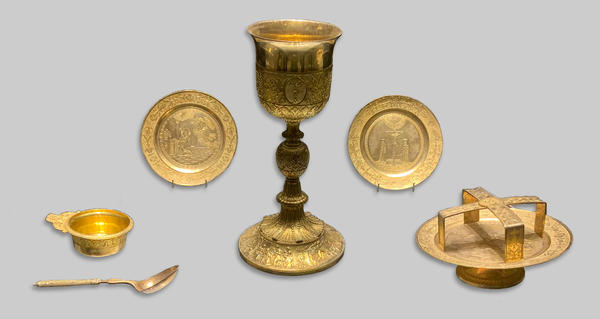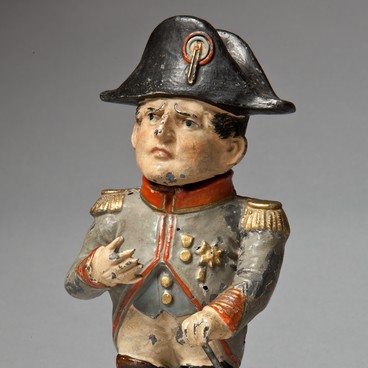The Liturgical Set consisting of seven items was made in Paris in 1814. The work was done by court jeweller of Napoleon I Martin-Guillaume Biennais (1764—1843) commissioned by Russian Emperor Alexander I. The sketches were done by Charles Percier, who, together with Pierre-François Fontaine, is called the creator of a new artistic fashion and founder of the Empire style.
Architects made sketches on the basis of carefully studying the ancient heritage and typical examples of Classic art. Alexander I commissioned in France two sets for celebrating liturgies. When he returned to Russia, he sent one of them to the Kazan Cathedral in St. Petersburg. Now this relic is kept in the State Hermitage collection. In 1815, the emperor sent the other one to St. Sophia’s Cathedral in Kiev. Now it is kept in the History Museum.
On April 10, 1814, when the Catholics and the Orthodox Christians celebrated Easter on the same day, Alexander I ordered an alter to be erected in La Place de la Concorde in Paris and have a public thanksgiving service. The weather on that day was gorgeous and a great many people gathered in the square and in the nearby park Le Jardin des Tuileries.
Later, the emperor, deeply moved by the event, described it in his letter to Prince Alexander Mikhailovich Golitsyn saying that the moment was solemn and even awesome. His Russian Orthodox warriors, who, by the will of Providence, had come from their northern motherland, were there offering a common prayer in the capital of France which had recently attacked Russia. The public prayer was happening in the place where not so long before the king had fallen victim to popular outrage. Alexander I wrote that when praying with his men according to the Orthodox tradition he felt that the bloody place where Marie-Antoinette and Louis XVI had been executed was being cleansed.
On that same day, April 10, on the opposite end of the country, the last battle of that war finished. The Anglo-Spanish troops led by Duke Arthur Wellington made an attempt to storm Toulouse. The city was being defended the army of Marshal Nicolas Soult and it gloriously withstood that bloody battle. Toulouse surrendered only on the next day, April 11, when the marshal was informed of the events in the capital and the abdication of Napoleon Bonaparte.
On April 11, a treaty was signed in the Palace of Fontainebleau between representatives of Russia, Austria, Prussia and Napoleon Bonaparte under which Napoleon forfeited power in France and was exiled to the Island of Elba.
Architects made sketches on the basis of carefully studying the ancient heritage and typical examples of Classic art. Alexander I commissioned in France two sets for celebrating liturgies. When he returned to Russia, he sent one of them to the Kazan Cathedral in St. Petersburg. Now this relic is kept in the State Hermitage collection. In 1815, the emperor sent the other one to St. Sophia’s Cathedral in Kiev. Now it is kept in the History Museum.
On April 10, 1814, when the Catholics and the Orthodox Christians celebrated Easter on the same day, Alexander I ordered an alter to be erected in La Place de la Concorde in Paris and have a public thanksgiving service. The weather on that day was gorgeous and a great many people gathered in the square and in the nearby park Le Jardin des Tuileries.
Later, the emperor, deeply moved by the event, described it in his letter to Prince Alexander Mikhailovich Golitsyn saying that the moment was solemn and even awesome. His Russian Orthodox warriors, who, by the will of Providence, had come from their northern motherland, were there offering a common prayer in the capital of France which had recently attacked Russia. The public prayer was happening in the place where not so long before the king had fallen victim to popular outrage. Alexander I wrote that when praying with his men according to the Orthodox tradition he felt that the bloody place where Marie-Antoinette and Louis XVI had been executed was being cleansed.
On that same day, April 10, on the opposite end of the country, the last battle of that war finished. The Anglo-Spanish troops led by Duke Arthur Wellington made an attempt to storm Toulouse. The city was being defended the army of Marshal Nicolas Soult and it gloriously withstood that bloody battle. Toulouse surrendered only on the next day, April 11, when the marshal was informed of the events in the capital and the abdication of Napoleon Bonaparte.
On April 11, a treaty was signed in the Palace of Fontainebleau between representatives of Russia, Austria, Prussia and Napoleon Bonaparte under which Napoleon forfeited power in France and was exiled to the Island of Elba.



